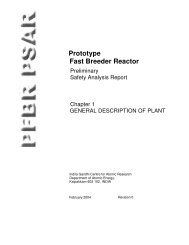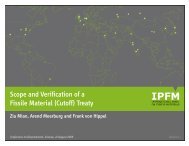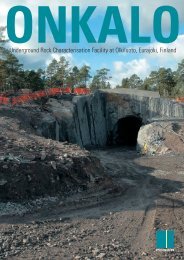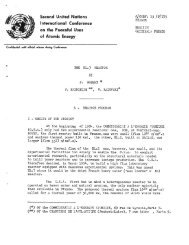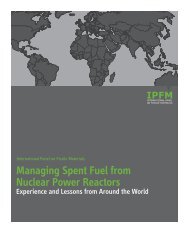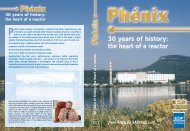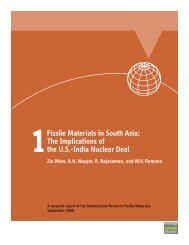Nuclear Proliferation TechnologyTrends Analysis - International ...
Nuclear Proliferation TechnologyTrends Analysis - International ...
Nuclear Proliferation TechnologyTrends Analysis - International ...
You also want an ePaper? Increase the reach of your titles
YUMPU automatically turns print PDFs into web optimized ePapers that Google loves.
PNNL -14480<br />
burn-up fuel only for the recovery of enriched uranium. ORNL also constructed the<br />
demonstration facility for the Purex process development. From 1950 through 1953, 7 kg<br />
of Plutonium & 7.5 MT of uranium were processed by the Purex process at the<br />
demonstration facility at ORNL. ORNL also built the Thorex demonstration for the<br />
reprocessing of thoria fuel for the recovery of U 233 . From 1954 through 1958,<br />
approximately 500 kg of U 233 was recovered at the ORNL facility. 163<br />
The Hanford/Redox was the first solvent-extraction process plant. The solvent employed<br />
was hexone (methyl isobutyl ketone) used with packed column contactors. Hexone is<br />
very volatile and flammable and has a poor decontamination factor. Construction<br />
commenced in 1949, with plant closure in 1967.<br />
The Idaho Chemical Plant made modifications to the Redox process. The updated process<br />
was used for Materials Test Reactor and spent naval reactor fuel reprocessing and<br />
involved the use of pulsed and packed columns. In 1992, reprocessing at the INEL<br />
Chemical plant was discontinued.<br />
The Purex process was used for separation of weapons grade Pu from 1956 until<br />
reprocessing was suspended in the United States. The Hanford Purex plant began<br />
construction in 1953 and was operational in 1956. It was inactivated in 1974, resumed<br />
operation 1983, and again shutdown in 1988.<br />
Savannah River had reprocessing plants using the Purex process, F Canyon (began<br />
operation in 1954) and H Canyon (began operation in 1955). F Canyon could reprocess<br />
9 metric tons of uranium fuel per day. Mixer-settlers and centrifugal contactors were<br />
added in 1966. Operation was suspended in 1992 and resumed in 1995 for stabilization<br />
runs, with shutdown projected in 2002.<br />
Argonne National Laboratory West developed a pyrometallurgical process for<br />
reprocessing the EBR-II fast reactor spent fuel. Argonne operated the process facility<br />
from 1963 through 1994.<br />
At West Valley, NY, a large Purex plant was constructed and operated from 1966<br />
through 1972. West Valley was capable of processing 300 tons of fuel per year.<br />
Escalating regulations required plant modifications and the plant was deemed<br />
uneconomical and shut down.<br />
A 300 ton per year plant was built at Morris, Illinois, incorporating new technology that<br />
was proven on a pilot-scale, but failed to work in production scale. The foundation of<br />
the process was solvent extraction with pulse column contactors.<br />
The construction of a 1500 ton-per-year plant at Barnwell, South Carolina, was aborted<br />
due to government policy change as one facet of the U.S. non-proliferation policy.<br />
163 “Fuel Reprocessing at ORNL,” J.W. Roddy, ORNL, 2000<br />
99



